



[TOKYO, JAPAN, 21 December 2011]
The Japan Committee for UNICEF (JCU) implemented the EYE SEE Project – a project that has been carried out by UNICEF around the world – in Iwate, Miyagi and Fukushima Prefectures for approximately one month starting on 5 November. The EYE SEE Project is part of JCU’s assistance campaign in response to the Great East Japan Earthquake.
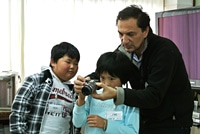 |
| © UNICEF/Japan 2011/Makiko Imai |
| Mr. Pirozzi and children. |
“EYE SEE” is a project carried out to promote children participation in society by providing them the opportunity to express their ideas and feelings and share them with those around them. This is achieved by offering children around the world that suffer from conflict, disaster, poverty and other issues the opportunity to take photographs. Since the project was first implemented in Pakistan in 2006, one year after the 2005 Kashmir Earthquake, it has been implemented in Liberia, Rwanda, Madagascar, South Africa, Ethiopia, Mali and other countries.
The 11 March Great East Japan Earthquake tremendously impacted children in the affected areas of Japan’s Tohoku region. Today, even more than nine months following the disaster, there is still a great need for assistance that will help restore normality to the lives of these children. Against this backdrop, efforts are underway by NPOs and volunteers to create opportunities for children to personally look back over their earthquake experience and to consider reconstruction for their communities. As part of this assistance, JCU invited Italian photographer Giacomo Pirozzi to facilitate the project’s implementation in Japan. Mr. Pirozzi has taken pictures for UNICEF for more than 20 years and has been an instructor for the children since the first installment of the EYE SEE Project.
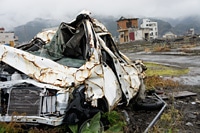 |
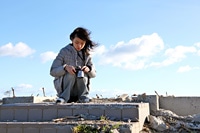 |
| © UNICEF/Japan 2011/Kaoru Sano | © UNICEF/Japan 2011/Giacomo Pirozzi |
| Leftover rubble. | A girl photographing the rubble. |
On the first day of the workshop the children took many pictures of the leftover rubble, emphasizing their starting point for engaging such a project. In the captions of their photographs, children inserted such phrases as, “This is what happened to where I used to play,” and “I’m sad.”
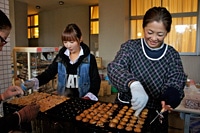 |
| © UNICEF/Japan 2011/Juri Fujiwara |
| A group of mothers preparing snacks in Haragama City. |
But Mr. Pirozzi encouraged the children to take their photos a step further, to go beyond taking pictures of the past and to take pictures of the present. When selecting a place in Fukushima Prefecture’s Soma City to take pictures of the “present”, the children chose a market where people left unable to run their previous businesses work on the weekends. The mother preparing snacks in the picture is the mother of one of the children taking the photograph. She spoke at length with all of the children as she continued turning the takoyaki dumplings in their pan, but apparently recalling some of the harder times that they had overcome, she nearly came to tears as she spoke. Not to let it get the best of her though, she continued to smile as she told the children, “We have to keep on strong!”
The children that took photographs of this mother inserted the following captions: “She said that she used to run a production company by the coast, but she lost her job after the tsunami. She also said that her house was damaged and that she is considering having it torn down.”
“She chats away with customers while she works. This disaster made Soma a more cheerful city with deeper bonds.”
At first the children perhaps only thought about the woman as “a friend’s mom.” However, after talking about the disaster with someone that was very close to them, they appeared more motivated and moved by the experience.
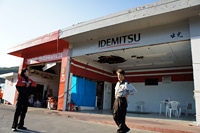 |
| © UNICEF/Japan 2011/Toshinori Sano |
| A married couple that reopened their gas station. |
These photographs were taken in Otsuchi Town in Iwate Prefecture. The two people standing in front of the recently reopened gas station are the parents of one of the photographer's classmates. When asked who they wanted to take a picture of that would represent the present and future of Otsuchi Town, the children quickly answered, "The man at the gas station!" And with that we headed off to take some pictures.
As a caption for the photo, the children chose the words of the couple: "We work hard now so that the town will return to normal. That will lead to reconstruction."
When one of the children asked how work was going after reopening the gas station, the man answered, "It is simply delightful." ?The children, overjoyed by his positive response, cheered as they said, "You're awesome!" Mr. Pirozzi then encouraged the children to take pictures of the couple from low angles, the side and all around. The children had surely taken away something special from the experience of talking with people that they knew that were working hard to overcome their adversities.
The children took many photos of their families as well.
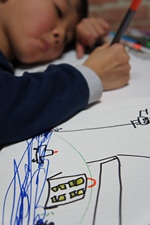 |
| © UNICEF/Japan 2011/Juri Fujiwara |
| A younger brother draws a picture of the tsunami. |
A girl in her third year in junior high school in Soma City, Fukushima Prefecture, chose to take pictures of her younger brother, who had been drawing pictures of the tsunami ever since the disaster. The boy apparently did not witness the tsunami himself, but continues to draw what he saw on television.
Her picture captions are as follows: “Drawing pictures. Normal primary school students would probably draw pictures of their favorite car or something like that.” “After the disaster the only thing on television was footage of the tsunami. Then it was the nuclear power station. We were only able to get in our pool twice this year.” “The picture in the front is the first tsunami picture he drew. After that he drew pictures of burning houses that were swallowed by the tsunami. He’s so young and he looks totally unfazed as he draws these pictures.” “The shock was too great. He may never be able to go back to before the disaster.”
As her captions show, her urge to take photos of her adorable younger brother were intertwined with the complex realities that they both faced.
 |
| © UNICEF/Japan 2011/Juri Fujiwara |
| A flower. |
In Fukushima Prefecture, where the nuclear power station incident took place, amidst the complex situation that remains, children seem to perceive the problems at hand from their own individual perspectives. In addition to direct expressions of their feelings, such as photos of dirt removed in decontamination activities and radiation measurement activities, there were innocent-looking pictures of flowers that bloomed in the children’s neighborhoods with captions like “I wonder if this has radiation” and “This flower bloomed despite the radiation,” revealing their emotionally unstable position in response to the radiation problem.
Mr. Pirozzi could be heard saying, “This is powerful!” upon viewing many of the photographs taken by the children. The children are accepting the diverse realities brought on by the disaster as is. When asked what they wanted to express or the meaning of their photographs they have trouble providing a clear answer, but maybe that is because they have yet to come up with a clear answer themselves. That is precisely why it is so important for us to view the photographs that they take from their own perspectives, to feel what they felt and to listen to what they say.
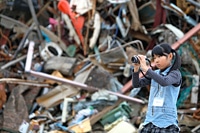 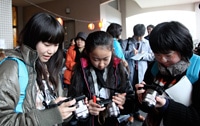 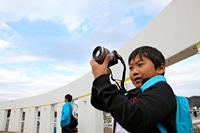 |
| © UNICEF/Japan 2011/Giacomo Pirozzi |
| Children taking photographs. |
JCU will be showcasing the photographs taken by these children on our website, at various locations throughout Japan and at an exhibit at UNICEF Headquarters in New York.
“Build Back Better” – when the decision was made to engage in assistance efforts in response to the Great East Japan Earthquake, these were the words that pushed along UNICEF’s efforts. This means that we make the situation even better than it was before. This concept is used to support emergency assistance efforts in response to natural disasters and conflict in developing countries to build the situation better than it was before. In developing countries, many children loose their lives from preventable disease and many are unable to attend school.
Many of Japan’s affected areas suffered from economically harsher situations than other areas from before the disaster, where the birth rate was dropping, society was aging and the younger generations were leaving for urban areas. The situation of children, and in particular preschool-age children, was discouraging, as was the situation of social services for child-rearing. The disaster only served to exacerbate the circumstances. There is no question that the disaster forced the environment of children and child-rearing into a place that was far more serious than before.
Child friendly cities and cities that are conducive to raising children not only serve the needs of children, but the needs of all ages of residents.
We hope that you will take this valuable opportunity to listen to the voices of the children in the disaster areas so that reconstruction is carried out in a manner that realizes a child friendly environment.
*This project was introduced by Mr. Yutaka Kikugawa, East Japan Assistance Headquarters Coordinator, on the 20 December edition of NHK Educational TV’s programme Shiten Ronten.
Click here for a report on Mr. Giacomo Pirozzi’s seminar and on the Great East Japan Earthquake Assistance Activities » (Japanese only)